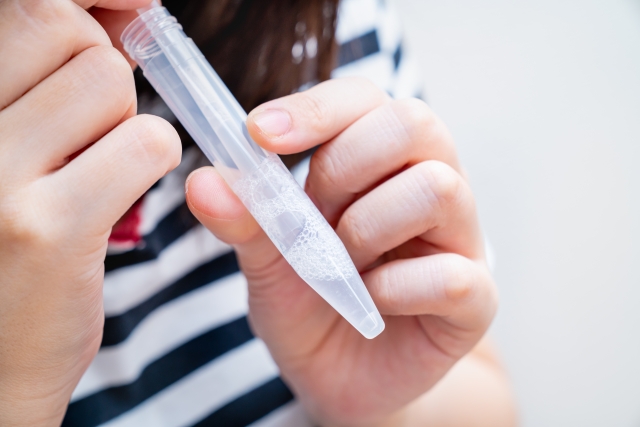Postnatal paternity testing by DNA extraction from saliva is a common and effective method widely used to confirm parent-child relationships. Saliva contains oral cells from which DNA can be extracted to confirm parent-child relationships. This method is very popular in paternity testing because it is simple and non-invasive (painless).
The following section details the procedure, benefits and precautions for parent-child identification by DNA extraction from saliva.
1. Procedure for DNA extraction from saliva
The process of saliva-based parent-child identification is very simple and involves the following steps
- Sample collection: saliva contains many oral cells and can easily be sampled by rubbing the oral mucosa with a cotton swab or special swab. Collection is painless and requires no special training, making it easy for anyone to perform.
- A special DNA identification kit is often provided and the sample is collected according to instructions and mailed to the laboratory in the envelope provided.
- Collection takes only a few minutes, as simply swabbing saliva or oral cells provides sufficient DNA.
- DNA extraction and analysis: from saliva samples arriving at the laboratory, cells are removed and DNA is extracted from them.The extracted DNA is analysed to compare specific parts of the genes between the parent and child.Mainly, short-strand repeat (STR) sequences are examined to confirm the match between parent and offspring.
- Reporting the results: once the DNA analysis has been completed, the results are reported. Usually, if a parent-child relationship exists, there is a probability of at least 99.99% that the parent-child relationship is proven. Conversely, if there is no parent-child relationship, the result is close to 0%.
2. The advantages of DNA analysis from saliva
Saliva-based paternity testing has several advantages.
- Non-invasive and easy sample collection: saliva and oral cell collection methods are painless and very easy to perform. This is particularly useful for children and babies, when painful methods should be avoided.
- Highly accurate DNA identification: saliva is rich in oral cells, which ensures that DNA can be extracted.This makes it possible to carry out parent-child relationships with a very high degree of accuracy.
- Convenience: samples can be taken easily at home and results received by post, providing hassle-free privacy.
3. The number of days required for appraisal
Typically, the time taken to obtain the results of a DNA parent-child test using saliva is as follows
- Typical appraisal: 1-3 weeks
- Results are usually reported within 1-3 weeks after the sample arrives at the laboratory.
- Express option: 3-7 days
- If you need results in a hurry, some institutions offer a service where you can pay an additional fee to receive your results more quickly.
4. Precautions when using saliva
- Effects of food and drink: when collecting a saliva sample, avoid eating or drinking before collection as eating or drinking immediately prior to collection may contaminate the sample.Laboratories usually advise against eating or drinking for at least 30 minutes before collection.
- Prevent sample deterioration: the collected saliva sample should be sealed promptly and mailed to the laboratory. It is important to send samples as soon as possible, as deterioration can destroy DNA and make analysis more difficult.
5. Costs and use as legal evidence
The cost of a parent-child test using saliva is almost the same as other methods (e.g. blood or hair).
- Cost: 30,000-100,000 yen is common. A simple appraisal carried out at home may cost between JPY 30,000 and 50,000, and between JPY 70,000 and 100,000 if used as legal evidence.
- Legal validity: normal home saliva testing is used for private verification, but for it to have legal validity, a formal procedure must be followed by a laboratory. For legal DNA testing, a third party must be present during sample collection and an official certificate is issued.
6. Advantages and disadvantages compared with other samples
- Benefit: Saliva samples are easy to collect, non-invasive and do not require special medical procedures, making them accessible to everyone. They are also highly accurate and provide reliable results.
- Disadvantages: saliva samples need to be taken under clean conditions as food and drink can affect them during collection. Also, additional procedures are required if they are to be used as legal evidence.
Summary
DNA extraction from saliva is a very effective, highly accurate and easy method of collecting samples in paternity testing. It can be performed easily at home and is widely used as a non-invasive and safe method. However, formal procedures and proof are required if it is to be used as legal evidence. It generally takes between one and three weeks to receive the results, but an express option is available for urgent cases.
Latest Articles
Supervisor of the article

Dr. Hiroshi Oka
Graduated from Keio University, Faculty of Medicine
Doctor of Medicine
Medical Doctor









